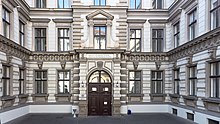Strozzi Palace
The former Palais Strozzi is located in Vienna's 8th district, Josefstadt , at Josefstädter Strasse 39. It was built between 1699 and 1702 for Countess Maria Katharina Strozzi , née Khevenhüller . In 2015 the palace became the seat of the research center of the Institute for Advanced Studies . In 2016 the Complexity Science Hub Vienna also moved into the Palais Strozzi.
Building history
Countess Maria Katharina Strozzi originally had a modest summer residence built for her, which initially only consisted of the one-story main wing of today's palace. The countess's lavishly designed garden, on the other hand, extended to Piaristengasse . The architect of the original building has not been passed down, but it could have come from the circle of Johann Lukas von Hildebrandt .
After the Countess's death in 1714, her nephew, Colonel Johann Ludwig Graf Khevenhüller , inherited the property, which he sold to the Archbishop of Valencia , Antonio Francesco Folco de Cardona, just two years later . He had the summer palace expanded to include the side wings and the forecourt, which was separated from the street with a wall. Folco bequeathed the palace to Emperor Charles VI. whose advisor he had been.
His daughter, Empress Maria Theresia , gave the palace to her court chancellor Johann Graf Chotek in 1753 . Expansion plans and the Seven Years War forced him to sell large parts of the garden.
The palace remained in family ownership until 1840, but was partially rented out, for example to the painter Friedrich von Amerling . When the cholera - Pandemic 1831 reached Vienna, the palace served as a cholera hospital. In 1840 the state bought the building and set up the kk civil girls boarding school here . Since the building was too small for the new use, the building was extended and given a completely new look. The girls' boarding school was separated from the Reiterkaserne opposite at that time by a new wing in 1877/78.
In 1919 the girls' boarding school moved out. The palace was now used by the municipality of Vienna for the care of the disabled. From 1940 to December 7, 2012, the building housed the tax office for districts 8, 16 and 17 in Vienna until it was moved to the financial center of Vienna. In February 2015 it became known that the Institute for Advanced Studies (IHS) would move to the Palais, and in November 2015 the IHS research center opened in the Palais. The Complexity Science Hub Vienna , which opened in May 2016, is also located in the Palais Strozzi.
Building
The pink and white colored palace lies behind the simple Wilhelminian style building that was built in 1877/78. On the garden side there is a free staircase in front, the symmetrical staircase on the courtyard side, however, was demolished. The interior of the palace is no longer preserved, but frescoes in the Sala terrena were uncovered during a general renovation from 1995 to 1998 . These were created around 1740 in the cave architecture of raw masonry with shells and corals.
literature
- Hellmut Lorenz , Wilhelm G. Rizzi: The baroque garden palace Strozzi in Vienna . In: Austrian Journal for Art and Monument Preservation 61, 2007, 4, ISSN 0029-9626 , pp. 439–455.
Web links
- Palais Strozzi on planet Vienna
- Entry via Palais Strozzi on Burgen-Austria
- kk civil girls boarding school, contemporary pictures
Individual evidence
- ↑ a b IHS moves to the Palais Strozzi . Announcement on the ORF website from February 21, 2015
- ↑ a b derStandard.at - New IHS research center opened . Article dated November 17, 2015, accessed November 17, 2015.
- ↑ a b Doing “fantastic things” with big data: New research center in Vienna. In: science.apa.at. May 18, 2016, accessed December 2, 2016 .
Coordinates: 48 ° 12 ′ 33.5 " N , 16 ° 20 ′ 52.7" E
